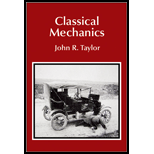
(a)
The natural choice for the normal coordinates
(a)
Answer to Problem 11.35P
The natural choice for the normal coordinates
Explanation of Solution
The Lagrangian equation of motion of the two coupled pendulum of Problem 11.14 is
Write the general equation of motion
Comparing the Lagrangian equation of motion and the general equation of motion
The
Where,
The function of this form satisfies the general equation of motion
Column matrix
When
When
In the first normal mode,
Writing the above matrices in equations
The solution to the above equation is
Thus, in the first normal mode, both the masses will oscillate with same amplitude and in phase with each other,
In the second normal mode,
Writing the above matrices in equation
The solution to the above equation is
Thus, in the second normal mode, both the masses will oscillate with same amplitude and are in out of phase with each other,
The eigenvectors
The eigenvector in matrix format
Determinate of the above matrix is
Since the determinate of
Therefore, the two eigenvectors
Therefore, the
Here,
Substitute the column matrix of
The equations from the above matrix
And,
Solving algebraically,
Substitute
Conclusion:
Therefore, the natural choice for the normal coordinates
(b)
Whether the equation of motion for
(b)
Answer to Problem 11.35P
It is proved that the equation of motion for
Explanation of Solution
The Lagrangian equation of motion of the two coupled pendulum of Problem 11.14 when it is subjected to a resistive force of magnitude
Write the general equation of motion
Comparing the Lagrangian equation of motion and the general equation of motion
The
Where,
The function of this form satisfies the general equation of motion
Column matrix
When
Let
When
Let
In the first normal mode,
Writing the above matrices in equations
The solution to the above equation is
Thus, in the first normal mode, both the masses will oscillate with same amplitude and in phase with each other,
In the second normal mode,
Writing the above matrices in equation
The solution to the above equation is
Thus, in the second normal mode, both the masses will oscillate with same amplitude and are in out of phase with each other,
The eigenvectors
The eigenvector in matrix format
Determinate of the above matrix is
Since the determinate of
Therefore, the two eigenvectors
Therefore, the
Here,
Substitute the column matrix of
The equations from the above matrix
And,
Solving algebraically,
Substitute
The natural choice of
Conclusion:
It is proved that the equation of motion for
(c)
The motion of the two pendulums for the two modes and describe.
(c)
Answer to Problem 11.35P
The equation of the motion of the pendulum for the first mode is
Explanation of Solution
From part (b), the eigenvalue equations can be written in the form of
The complex column
The real form of
Therefore, the equation of the motion of the pendulum for the first mode is
For second mode,
Therefore, the equation of the motion of the pendulum for the second mode is
Conclusion:
The equation of the motion of the pendulum for the first mode is
Want to see more full solutions like this?
Chapter 11 Solutions
Classical Mechanics
 College PhysicsPhysicsISBN:9781305952300Author:Raymond A. Serway, Chris VuillePublisher:Cengage Learning
College PhysicsPhysicsISBN:9781305952300Author:Raymond A. Serway, Chris VuillePublisher:Cengage Learning University Physics (14th Edition)PhysicsISBN:9780133969290Author:Hugh D. Young, Roger A. FreedmanPublisher:PEARSON
University Physics (14th Edition)PhysicsISBN:9780133969290Author:Hugh D. Young, Roger A. FreedmanPublisher:PEARSON Introduction To Quantum MechanicsPhysicsISBN:9781107189638Author:Griffiths, David J., Schroeter, Darrell F.Publisher:Cambridge University Press
Introduction To Quantum MechanicsPhysicsISBN:9781107189638Author:Griffiths, David J., Schroeter, Darrell F.Publisher:Cambridge University Press Physics for Scientists and EngineersPhysicsISBN:9781337553278Author:Raymond A. Serway, John W. JewettPublisher:Cengage Learning
Physics for Scientists and EngineersPhysicsISBN:9781337553278Author:Raymond A. Serway, John W. JewettPublisher:Cengage Learning Lecture- Tutorials for Introductory AstronomyPhysicsISBN:9780321820464Author:Edward E. Prather, Tim P. Slater, Jeff P. Adams, Gina BrissendenPublisher:Addison-Wesley
Lecture- Tutorials for Introductory AstronomyPhysicsISBN:9780321820464Author:Edward E. Prather, Tim P. Slater, Jeff P. Adams, Gina BrissendenPublisher:Addison-Wesley College Physics: A Strategic Approach (4th Editio...PhysicsISBN:9780134609034Author:Randall D. Knight (Professor Emeritus), Brian Jones, Stuart FieldPublisher:PEARSON
College Physics: A Strategic Approach (4th Editio...PhysicsISBN:9780134609034Author:Randall D. Knight (Professor Emeritus), Brian Jones, Stuart FieldPublisher:PEARSON





